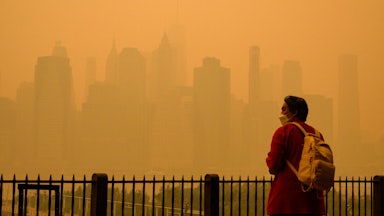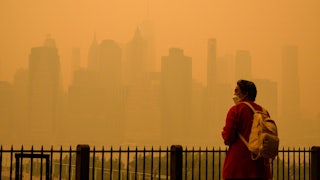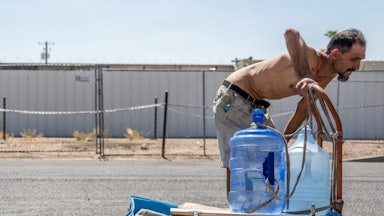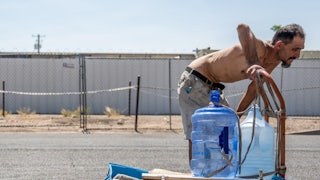As fierce as debates over nuclear energy, carbon capture, or, oddly, bananas, can be, perhaps an even more contentious question among people who work on climate is how we should feel about the climate crisis.
First, let’s acknowledge the weird middle ground in which we find ourselves. On the one hand, we’re making more progress than ever on climate change, in ways that would have seemed impossible only a couple years ago: The federal government is spending billions on decarbonization, solar and wind energy have gotten exponentially cheaper, and New York state is going to build publicly funded renewable energy. Then again, we’re seeing the disastrous effects of climate change every day—enduring the worst heat waves on record, breathing pollution from wildfires no matter where we live—and rapidly running out of time to change course. There’s ample fodder for both optimism and pessimism.
Which attitude is the most productive? Which is the right one to galvanize people to action and ignite real change? The debate keeps dragging on. For some years—going back at least to 2009, when researchers Christina Faust and William O’Shannon Murphy warned of the pitfalls of the “apocalyptic tragedy” narrative in climate discourse—many within the climate movement have observed that their fellow activists’ rhetoric about the crisis is as likely to provoke retreat as action. They’ve got a point: Research shows that much of the public responds to dire doomsday fearmongering by tuning out.
Since then, worry about the climate crisis has been steadily increasing: Yale researchers have found that the number of people who are “alarmed” about the issue has tripled over the past six years. The increasing visibility of the crisis itself is, in some cases, causing real mental health problems, especially among the young.
It’s probably good for the climate movement to provoke “alarm,” but not all the extreme distress is useful or reality-based. Climate communicators like Alaina Wood, a young sustainability scientist, say it’s important not to let misinformation (for example, the common misbelief that the world is literally ending in eight years, a misreading of the Intergovernmental Panel on Climate Change warnings on irreversible climate change) ruin people’s lives or lead to depressive resignation on the issue. “People are giving up on activism,” because of such narratives, Wood told the BBC in May. She emphasized that encouraging people to feel scared but determined to work for change is different from fueling “‘I’m giving up and having mental breakdowns’ eco-anxiety.”
Accordingly, many communicators have shifted emphasis away from dystopian scenarios. Wood, for example, has a TikTok account focusing on solutions and debunking those apocalyptic narratives that aren’t scientifically grounded. Her message is resonating: Wood’s follower count tripled to more than 300,000 after she shifted to this emphasis. Other influencers on what’s known as EcoTok have also increasingly begun emphasizing climate solutions. And it’s not just TikTok. The mainstream media has been making a similar shift from all-doom-all-the-time to reporting the occasional positive development. Outlets like The Washington Post, The New York Times, and NPR now have entire positions devoted to reporting on climate solutions.
It’s hard to argue against the idea that there is real progress being made on climate over the past few years—even if your position is that progress can’t hold a candle to the scale of the problem. That’s one reason that some of the most prominent climate thinkers have recently seemed to shift in how they talk about climate change.
In 2017, New York magazine published David Wallace-Wells’s essay “The Unhabitable Earth,” which became the most-read article in the history of the magazine. Wells’s writings—including his bestselling 2019 book with the same title as his essay—have served to wake up so many people to the apocalyptic potential of the climate crisis. (It’s worth noting that many scientists took issue with the possibilities laid out in Wells’s 2017 essay, saying that emphasizing only the worst-case scenarios was not in scientific good faith.) But Wells seems to be feeling more optimistic these days, writing that he believes that the earth can remain habitable and that it’s no longer likely warming will escalate to three or four degrees, with the “most terrifying predictions made improbable by decarbonization.” Wells said in a recent interview that the outlook “looks a lot happier to me than when I wrote the book and certainly when I wrote the article that kicked me off into this story.… I think the world is genuinely waking up.” Though he anticipates a lot of climate chaos in the medium term, he said, “I think, in the long term, the battle is going to be won.”
But for others, this attitude is the wrong one. In April, Harper’s Magazine published a critique of media climate optimism as its cover story. In “The Incredible Disappearing Doomsday,” Kyle Paoletta wrote about “how the climate catastrophists learned to stop worrying,” and took Wallace-Wells (among others) to task for being too optimistic on the possible paths forward for our burning planet. Meanwhile, in a 2022 Nation essay headlined “Against Climate Optimism,” Wen Stephenson accused those taking victory laps over less-drastic warming projections and Raphael Warnock’s Senate win as “settling for genocide,” repeating a common claim that climate optimists are insensitive to the suffering global warming is causing, and will cause, the global poor. The same writer in April revisited the theme, calling the media’s climate optimism a “cruel fantasy” because there is still not enough political will for the revolution required to reduce our carbon emissions. And there’s always someone who can make doomerism into a contest. In a July essay in Current Affairs called “Climate Optimism Is Dangerous and Irrational,” Jag Bhalla criticized Paoletta’s essay for being too optimistic. It’s an example of what the late Martin Amis called “one-downsmanship,” and it can be an almost competitive sport in climate discourse.
These critics are not wrong that people are dying, nor about the vast gap between our political culture and what needs to be done. Optimism can look suspiciously like greenwashing, especially at the speed that capitalists have been embracing it. And passive hope—what climate writer Mary Heglar calls “hopium”—can make us too complacent. There must be space in our discourse for climate grief and anxiety, not least because there is plenty of scientific and political basis for those feelings.
Yet doomerism is probably more dangerous than the optimism these essayists criticize, because it forecloses that political will altogether. It’s not true that we are all doomed. A doomed population can’t do anything to solve the problem—and therefore doesn’t have to. Doomerism is worse even than climate denial, because denialists wouldn’t be doing anything to fix climate change anyway.
Either way, you’re entitled to your feelings. We all feel doomy or optimistic depending on the day, sometimes for rational reasons. But our narratives should be true and responsible—which means neither the totally positive nor totally negative affect is quite right.
Charlie Heller, who’s part of a group of ecosocialists in the Democratic Socialists of America that helped to pass New York’s renewable energy bill, agrees. “Doomism is the worst,” he told me, “but we also don’t want people to feel blindly hopeful.” Instead, he said, we want people to understand that the climate crisis is serious but that with serious and committed political action we can mitigate the problem. We can’t stop it, but we can save many human lives, great civilizations, beloved species, and vital ecosystems. Call it a tempered pessimism or a cautious optimism, but it’s the only defensible approach to climate change. The crisis is serious, but everything we do right now matters, and is saving lives.
All the most serious climate policy—whether it’s policy in Washington or at the city and state level—comes out of the recognition that as a species, we are staring extinction in the face. But such progress also wouldn’t be happening without large numbers of people taking a leap of faith that humans can address this problem and bothering to do all the nitty-gritty, ultimately optimistic work of pressuring politicians and standing up to the fossil fuel industry. Whatever our feelings might be, political victories like these are all that matter, not only for the carbon they remove from the earth but because they undermine the dangerous narratives that nothing can be done—and the complacent hope that someone else is already doing it.










